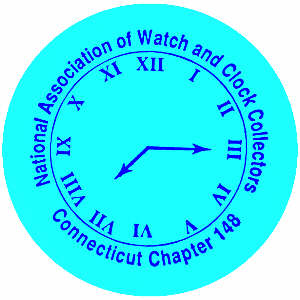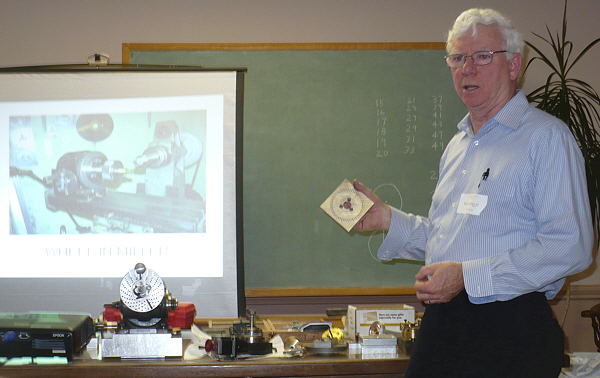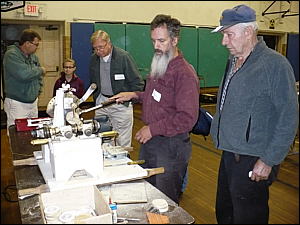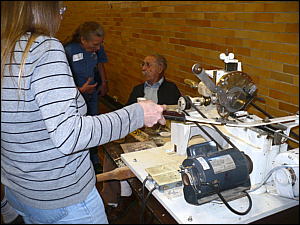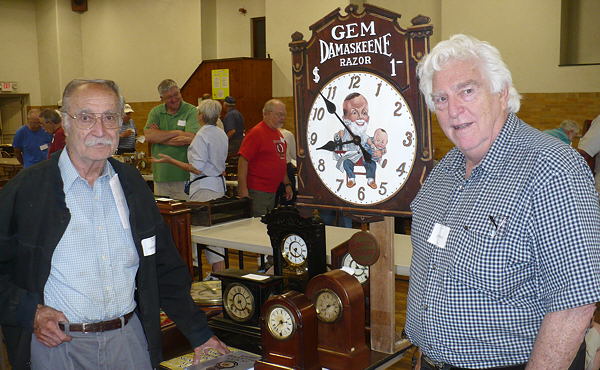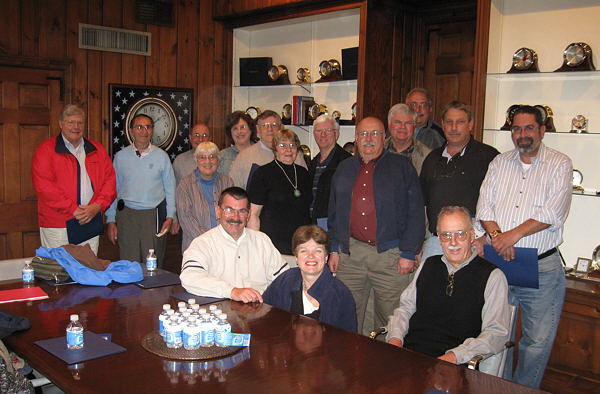NEXT MEETING - January 16, 2009Edmond Town Hall,
Chapter 148 meets on the 3rd Saturday of odd months. * * * Meetings PastNovember 21, 2009 Meeting Highlights The Chapter held its last meeting of 2009 with a nice turnout of some 125 members and guests. In addition to the regular fare of doughnuts, pastries, bagels, and beverages, this holiday season brings with it the Chapter's tradition of affording some "lucky" members a chance of winning one of 12 fruit baskets prepared by Cheryl and Al Comen. Thanks Cheryl and Al for your efforts in continuing this tradition on behalf of the Chapter. The President of the United States is limited to a maximum of eight years in office, but Jim Katzin has ably served as the Chapter's President for some 12 years. He reluctantly (and understandably) is steping down from this role where he has committed much of his time for the benefit of the Chapter. Jim, a simple "thank you" hardly conveys sufficient recognition for your long and dedicated service. On behalf of all Chapter 148 members - a big and long overdue "Thank You". At this meeting, the Chapter elected John Salva as President, replacing Jim. We welcome John to this new role, which, in fact, is hardly new to him. John was instrumental in the founding of Chapter 148, almost 20 years ago. In addition, the Chapter re-elected Cheryl Comen to the position of Treasurer, while the writer was elected Secretary. The upstairs meeting room at the Edmond Town Hall was barely sufficient to house all the members eager to hear a presentation by Bill Curley on the theory and practice of wheel cutting. Bill is certainly no stranger to the Chapter where he is a regular at meeting marts, displaying the finest pieces of machined metal one can imagine. His knowledge and talent in metal working is plenty evident in his finished product, but the real extent of his capabilities becomes clear at a presentation like this one. Bill's equipment filled the front table and his formulas filled the front screen. His presentation dove right into the math of machining, lots of math. The ongoing issue of inch and millimetre (English and Metric) measurements needs attention right up front. The mathematical calculations are required to properly determine the module which will establish the "cutter" configuration for a particular wheel-cutting operation. Bill indicated that in working with the time train, simple teeth counts can be established, but with the strike train, more complicated math is required to determine the cutters needed for a given module. Some modules could require three cutters: standard; short form; and round bottom. Cutters cost approximately $100.00 each which Bill acquires from P.P. Thornton in England.
Bill Curley demonstrates a little math along with the metal. Using much of the equipment he was kind enough to bring along for this presentation, Bill explained the steps for blank making where precision measuring equipment is needed. Bill, the Chapter conveys a well-deserved thank you for sharing your time, talent and knowledge with us. On a sad note, I report the death of Russ Ferris of Maynard, MA. He died in early November. Russ was a regular tableholder at Chapter 148 Marts and will be greatly missed by all those who enjoyed talking clocks and watches with him. The Chapter extends its sympathy to Russ' family and friends. * * * September 19, 2009 Meeting Highlights The Chapter held its regularly, scheduled fall meeting on September 19 at the Edmund Town Hall in Newtown. While slightly fewer members than usual, the fine fall day did not prevent some 100 members and guests from attending and enjoying a little "clock & watch talk" and some friendly socializing over coffee and doughnuts. The September program was integrated into the morning mart schedule and thus allowed for a more casual discussion and some personal hands-on instruction by the master of wooden wheel cutting, George Bruno. George brought along his hand-made, personally engineered, wooden wheel, cutting machine. This machine is a marvel of engineering which replicates how wooden wheels were cut on thousands of early-nineteenth century clocks. One's appreciation of the accuracy of the machine is over-shadowed only by the simplicity that George has built into its operation. A few minutes of instruction by George and members were cutting teeth like seasoned machinists. An indexing plate on the rear of the unit allows the operator to consistently cut each tooth with a minimum of effort. Adjust the indexing plate and one changes the wheel's configuration. Easy to use and fun to watch, this unit provides an understanding of the early techniques for producing interchageable parts. If you have not spent some time discussing "wooden works" with George, you have truly lost an opportunity to learn from one of the icons in the field. George, the Chapter thanks you for sharing your knowledge and understanding of the wooden wheel. Chapter President, Jim Katzin (left picture), tries out the machine while Chapter members look on. A seated George Bruno, as always, is willing to "talk shop". [click pictures for larger view] * * * July 18, 2009 Meeting Highlights The Chapter held its mid-summer meeting on July 18 with a nice turnout of close to 100 members and quests, in spite of the hot, humid weather and it being the peak vacation season. The usually comfortable Edmund Town Hall (basement) was a bit humid as evidenced by the consistently, hard-working Jon Jacobi. Jon routinely arrives at the Hall (traveling from Long Island) before the Mart begins to set-up tables and chairs in time for the 8:00 AM opening. Jon, a big thank you from the Chapter members for performing one of those often unseen, overlooked tasks, so necessary to a smoothly functioning Mart. As has been the case in the past, there was no formal program for this mid-summer meeting, but the Mart activity was lively as usual. The accompanying photo from the July Mart shows two members whose attendance can regularly be counted on. Jerry Maltz, author of Baird Advertising Clocks, and George Bruno, who needs no introduction to clock folks, take note of one of Jerry's unusual adverting clocks.
George Bruno (left) and Jerry Maltz Speaking of George Bruno, plan on attending the Chapter 148 meeting on September 19 where George will demonstrate wooden-wheel cutting and other of his many talents. * * * May 16, 2009 Meeting Highlights The Chapter held its third meeting of the year in the Edmund Town Hall in Newtown with a consistently good turnout of some 120 members. As a result of her behind the scenes preparation, Cheryl Comen kept attendees flowing into the hall smoothly as usual. A big thank you, Cheryl, for all your efforts on behalf of the Chapter. Mart activity was lively with plenty of trading and clock and watch "talk". The Chapter welcomed Mel Smith as speaker for its May program. Mel's talk filled the room with members and his display of "tools and toys", likewise filled the presentation table. Mel's focus was on the jeweler's lathe and its many uses in clock and watch work. Like most experienced and talented repairers, Mel makes many of his own tools and attachments. For gravers, his preference is cobalt, high-speed steel. When drilling with a lathe, he recommends using a spade bit rather than a twist drill bit, the latter tends to "walk". On pivot work, use a burnishing tool, not abrasives, which also hardens the pivot steel. At the end of his formal presentation, Mel gave the group an opportunity to try the lathe and to "handle" the many tools and attachments that he brought along, many members took him up on it. The "post" presentation talk continued for some time as members took advantage of the "hands-on" portion of the session. Thank you, Mel, for your time, presentation, and extensive display of tools. Dr. David Follett is one member who can usually be counted on to bring along some unusual and informative material. Displayed were two beautifully and extensively carved shelf clocks by Mitchell and Atkins, ca. pre-1830. Unusual was the detailed "British"-looking carvings on the splat, thought, perhaps, to have been carved by a Goshen, NY carver. Interestingly, the tablet depicts a painting of the "new" White House in Washington (remember, the British burned the building in the War of 1812. Was this clock an effort to "heal" the post-war wounds between the two nations? David also displayed two very early German clocks (ca. 1600-1700), which he feels provided the historical basis for the Connecticut woodenworks shelf clock industry. The first, by Johannes Buchsman, was known as a "Teleheur" or "platter clock". It rested flat on and parallel to the table top. The second, by Evgen von Stiert, was shaped like a large "shield" (still called a Teleheur) and hung on the wall. See David for more on this "origin " of the domestic house clock. Thank you David for always adding to our knowledge of horology. On May 7, 2009, a group of Chapter members took a trip to Boston for a tour of the Chelsea Clock Company. The Chelsea Clock Company began in 1897 and is still in operation in Boston. See the Chapter's comments in the April issue of the Bulletin for background on the Company or visit their website. The group was given a guided tour of the facility and had an opportunity to speak with both management and many of the long-time workers in the plant.
The Chapter thanks the management and workers of the Company, especially; Susan Capone, Lisa Polidoro, Terry Kubarsky, and Anthony LaChapelle, for hosting this tour in a most gracious manner. And thanks to John Bieback, Chapter member, who initiated and organized the trip. * * * March 21, 2009 Meeting Highlights The tough and relentless New England Winter seemed to give way this Saturday and any remaining cabin fever was relieved as members and guests lined up early in good numbers. Exceeding January's meeting, some 130 plus folks turned out to: talk clocks and watches and attend a program with a unique twist on the clock theme. The Mart activity was brisk with plenty for everyone: clocks; watches; parts; and books. For those with no incentive to trade, there was the usual pastries, bagels, beverages, and fellowship to fill the time. One member who can usually be counted on to fill the time of passersby is Dr. David Follett. Dave brought along a beautiful Reeded Column Pillar and Scroll clock by Merriman, Birge & Co., ca. 1822. The clock, with a thirty-hour time and strike wooden movement and roller pinions, is similar to one at the American Clock and Watch Museum in Bristol, CT. Dave's varied and extensive interest in Horology is evident by the two other French clocks sitting on his table: one at Versailles ca. 1675-1680; and a LeRoy, Paris, ca. 1700-1705. Both clocks are capable of running for one month. Members were treated to an excellent presentation by Steve Hall of an unusual Horological theme - postage stamps. Steve, a pharmaceutical engineer residing in Connecticut, began collecting stamps as a youngster in the 1950's, but his focus on stamps with an Horological theme coincided with a move to Germany in the 1990's. Already a clock collector, he was impressed by the more serious attention given to "clock stamps" in Europe as compared with the United States. His residence in Germany gave him access to stamp collectors there as well as in neighboring countries. The images on these European stamps provided him with an incentive to visit the "actual site" depicted. Hence, stamps were collected and visits often made to: Poland; Luxembourg; Netherlands; Hungrary; Romania; etc. The Hungarians produced some very beautiful stamps. Horological themes are not limited, however, to Europe; smaller countries like: Malta; Tonga; and the Isle of Man, likewise, issue unusual related stamps. The engineer in Steve is somewhat evident by his constructive and useful categorization of his stamps: clocks; tower clocks; sun dials; wrist and pocket watches; flower clocks; and astrological insturments. But softer themes are also included: culture; pop cultures; symbolism; and people (famous clockmakers). Steve's reasons for his interest in Horological stamp collecting are understandable: love of History; appreciation of fine art; opportunity to travel or stay closer to home and stamp clubs; and, besides, stamps are less expensive than clocks. Steve is the author of an excellent article which appeared in the NAWCC Bulletin No. 346 in October, 2003, entitled: "Timepieces on Postage Stamps". I encourage you to read it. The pictures just might be infectious. Steve, we thank you for sharing your interests and broadening ours. * * * January 17, 2009 Meeting Highlights Chapter 148 kicked off the new year with even more enthusiasm than it left the last. Over 120 members and guests braved the clear, but very cold January weather, to do what all clock lovers enjoy doing: talking clocks and watches. Most all Mart tables were filled and discussions were lively. No sign of recession or credit crunch here. There was no formal program scheduled for this January meeting, but the traditional raffle kept most all attendees until the end of the morning. Chapter President, Jim Katzin, in connection with his regular meeting comments, raised the possibility of a Chapter tour sometime this spring. While early in the planning stages, Jim is trying to organize a tour of the Chelsea Clock Company factory sometime during the months of May or June. The tentative plans call for renting a van to hold approximately 10 members for a weekday trip to the factory in Chelsea, Massachusetts. Movement on the plan is dependant upon the level of member feedback. In this regard, Jim asked members to contact him in the weeks ahead to express any possible interest. He can be contacted at mantelclock@yahoo.com. This sounds like a great opportunity to get an inside look at one of the survivors of the U.S. clock industry. The Chelsea Clock Company certainly has a long and storied history. In 1842, Edward Howard, who apprenticed under Simon Willard's nephew, founded the E. Howard Clock Company. Howard then taught an inventive apprentice named Joseph Eastman, who later founded the Eastman Clock Company. While Eastman's business venture ulimately ended in bankruptcy, it was not until after he had built a new factory for his nacent business in Chelsea, Massachusetts. After a brief time, the property was purchased on July 23, 1897 by Charles Pearson and shortly thereafter he began to operate the factory as the Chelsea Clock Company. This original site remains the home of the Chelsea Clock Company today. The ownership of the Company has changed hands over the last 100+ years and most recently, in 2005, was purchased by JK Nicholas, a business consultant, entrepreneur, and longtime collector of Chelsea clocks. Today the Company hand assembles and services clocks at the same factory where it had its beginnings in 1897. This potential tour sounds like a great opportunity to see a great company and experience history. Contact Jim if you have any interest. Meetings In 2008 |
